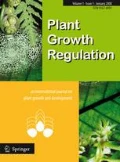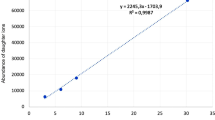Abstract
The characterization by capillary gas chromatography-mass spectrometry of the plant hormones indole-3-acetic acid and the gibberellins GA1 and GA3 from chemically-defined cultures of Acetobacter diazotrophicus and Herbaspirillum seropedicae is reported. Both bacteria are endophytic in gramineae species where they promote growth and yield. Quantification was also done by selected ion monitoring with [17,17-2H2]-Gibberellin A1, [17,17-2H2]-Gibberellin A3 and [13C6]-indole-3-acetic acid as internal standards. The results presented show the importance of studying phytohormonal production when the interrelationships between plants and microorganisms are analyzed and may help explain the beneficial effects of endophytic bacteria to the host plant, as has been demonstrated previously for Azospirillum spp.
Similar content being viewed by others
References
Basham Y and Levanony H (1990) Current status of Azospirillum inoculation technology: Azospirillum as a challenge of agriculture. Canadian Journal of Microbiology 36: 591–608
Boddey RM and Döbereiner J (1988) Nitrogen fixation associated with grasses and cereals: recent results and perspectives for future research. Plant and Soil 108: 53–65
Bottini R, Fulchieri M, Pearce D and Pharis RP (1989) Identification of gibberellins A1, A3 and iso-A3, in cultures of Azospirillum lipoferum. Plant Physiology 90: 45–47
Calvacante VA and Döbereiner J (1988) A new acid-tolerant nitrogen-fixing bacterium associated with sugarcane. Plant and Soil 108: 23–31
Chen KH, Miller AN, Patterson GW and Cohen JD (1987) A rapid and simple procedure for purification of indole-3-acetic acid prior to GC-SIM-MS analysis. Plant Physiology 86: 822– 825
Crozier A, Arruda P, Jasmin J, Monteiro AM and Sandberg G (1988) Analysis of Indole-3-Acetic Acid and Related Indoles in Culture Medium from Azospirillum lipoferum and Azospirillum brasilense. Applied and Environmental Microbiology 54: 2833–2837
Döbereiner J and Baldani JI (1992) Bases científicas para uma agricultura biológica. Ciencia e Cultura 34: 869–881
Döbereiner J, Reis VM, Paula MA and Olivares F (1993) New Horizons in Nitrogen Fixation. Dordrecht: Kluwer Academic Publishers
Ehmann A, Bandurski RS, Harten J, Young N and Sweeley CC (1975) Mass spectrometry of indoles and trimethylsilyl-indole derivatives. East Lansing: Michigan State University
Fuentes Ramírez LE, Jiménez Salgado T, Abarca Ocampo IR and Caballero Mellado J (1993) Acetobacter diazotrophicus an indoleacetic acid producing bacterium isolated from sugarcane cultivars of Mexico. Plant and Soil 154: 145–150
Fulchieri M, Lucangeli C and Bottini R(1993) Inoculationwith Azospirillum lipoferum affects growth and gibberellin status of corn seedling roots. Plant and Cell Physiology 34: 1305–1309
Kapulnik Y, Gafny R and Okon Y (1985) Effect of Azospirrillum spp. on root development and NO3 uptake in wheat (Triticum aestivum c.v. Miriam) in hydroponic systems. Canadian Journal of Botany 63: 627–631
Kovats E (1958) Gas-chromatographische Charakterisierung organischer Verbindungen. Teil 1: Retention Indices aliphatischer Halogenide, Alkohole, Aldehyde und Ketone. Helvetica Chimica Acta 41: 1915–1932
Lucangeli C and Bottini R (1996) Reversion of dwarfism in dwarf-1 maize (Zeamays L.) and dwarf-x rice (Oryza sativa L.) mutants by endophytic Azospirillum spp. Biocell 20: 223–228
Nishijima T and Katsura N (1989) A modified micro-drop bioassay using dwarf rice for detection of femtomol quantities of gibberellins. Plant and Cell Physiology 30: 623–627
Okon, Y (1985) Azospirillum as a potential inoculant for agriculture. Trends in Biotechnology 3: 223–228
Piccoli P and Bottini R (1994) Effect of C/N ratio, N content, pH, and incubation time on growth and gibberellin production by Azospirillum lipoferum. Symbiosis 17: 229–236
Piccoli P, Masciarelli O and Bottini R (1996) Metabolism of 17,17[2H2]-Gibberellins A4, A9 and A20 by Azospirillum lipoferum in Chemically-Defined Culture Medium. Symbiosis 21: 263–274
Tien TM, Gaskins MH, Hubbell DH (1979) Plant growth substances produced by Azospirillum brasilense and their effect on the growth of pearl millet (Pennisetum americanum L.). Applied and Environmental Microbiology 37: 1016–1024
Author information
Authors and Affiliations
Rights and permissions
About this article
Cite this article
Bastián, F., Cohen, A., Piccoli, P. et al. Production of indole-3-acetic acid and gibberellins A1 and A3 by Acetobacter diazotrophicus and Herbaspirillum seropedicae in chemically-defined culture media. Plant Growth Regulation 24, 7–11 (1998). https://doi.org/10.1023/A:1005964031159
Issue Date:
DOI: https://doi.org/10.1023/A:1005964031159




